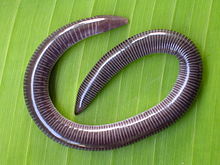Uraeotyphlus
| Indian caecilians | |
|---|---|

| |
| Uraeotyphlus narayani | |
| Scientific classification | |
| Kingdom: | |
| Phylum: | |
| Subphylum: | |
| Class: | |
| Order: | |
| Family: | Uraeotyphlidae Nussbaum, 1979
|
| Genus: | Uraeotyphlus W. Peters, 1879
|
| Species | |
|
Uraeotyphlus gansi | |
Uraeotyphlidae is the family of Indian caecilians. It is a monotypic family containing a single genus, Uraeotyphlus. Alternatively, Uraeotyphlus is placed in the family Ichthyophiidae.[1] There are seven species of caecilians in this genus, all of which are found in the Western Ghats in Kerala State, peninsular India.[2]
They are relatively small sized caecilians ranging from 23 centimetres (9.1 in) to 30 centimetres (12 in) in length. Unlike the more 'advanced' caecilians, members of this family have a true tail with vertebrae, and their skull has a relatively complex structure. However, unlike the more 'primitive' caecilians, the mouth is recessed below the snout, there are no tertiary annuli, and the tentacular opening are far forward of the eyes, and below the nostril.[3] Molecular studies support their placement as a sister taxon to Ichthyophiidae.
They are burrowing animals, which lay eggs that hatch into free-living larvae.[3] Their habitat is primarily the soil of the tropical forest floor.
Taxonomy
Family Uraeotyphlidae
- Genus Uraeotyphlus[2]
- Uraeotyphlus gansi – Gansi Caecilian
- Uraeotyphlus interruptus – Kerala Caecilian
- Uraeotyphlus malabaricus – Malabar Caecilian
- Uraeotyphlus menoni – Menon's Caecilian
- Uraeotyphlus narayani – Narayan's Caecilian
- Uraeotyphlus oommeni – Bonnacord Caecilian
- Uraeotyphlus oxyurus – Red Caecilian
References
- ^ Frost, Darrel R. (2013). "Ichthyophiidae Taylor, 1968". Amphibian Species of the World 5.6, an Online Reference. American Museum of Natural History. Retrieved 23 April 2013.
- ^ a b Frost, Darrel R. (2013). "Uraeotyphlus Peters, 1880". Amphibian Species of the World 5.6, an Online Reference. American Museum of Natural History. Retrieved 23 April 2013.
- ^ a b Nussbaum, Ronald A. (1998). Cogger, H.G.; Zweifel, R.G. (eds.). Encyclopedia of Reptiles and Amphibians. San Diego: Academic Press. pp. 55–56. ISBN 0-12-178560-2.
- Nussbaum, Ronald A. and Mark Wilkinson (1989). "On the Classification and Phylogeny of Caecilians." Herpetological Monographs, (3), 1–42
- San Mauro, Diego; David J. Gower; Oommen V. Oommen; Mark Wilkinson; Rafael Zardoya (November 2004). "Phylogeny of caecilian amphibians (Gymnophiona) based on complete mitochondrial genomes and nuclear RAG1". Molecular Phylogenetics and Evolution. 33 (2): 413–427. doi:10.1016/j.ympev.2004.05.014. PMID 15336675.
- San Mauro, Diego; Miguel Vences; Marina Alcobendas; Rafael Zardoya; Axel Meyer (May 2005). "Initial diversification of living amphibians predated the breakup of Pangaea". American Naturalist. 165 (5): 590–599. doi:10.1086/429523. JSTOR 10.1086/429523. PMID 15795855.
- San Mauro, Diego; David J. Gower; Tim Massingham; Mark Wilkinson; Rafael Zardoya; James A. Cotton (August 2009). "Experimental design in caecilian systematics: phylogenetic information of mitochondrial genomes and nuclear rag1". Systematic Biology. 58 (4): 425–438. doi:10.1093/sysbio/syp043. PMID 20525595.
- Gower, D. J, Alex Kupfer, Oommen V. Oommen, Werner Himstedt, Ronald A. Nussbaum, Simon P. Loader, Bronwen Presswell1, Hendrik Mueller, Sharath B. Krishna, Renaud Boistel and Mark Wilkinson (2002) A molecular phylogeny of ichthyophiid caecilians (Amphibia: Gymnophiona: Ichthyophiidae): out of India or out of South East Asia? Proc. R. Soc. Lond. B 269:1563–1569 PDF
- AmphibiaWeb: Information on amphibian biology and conservation. [web application]. 2004. Berkeley, California: AmphibiaWeb. Available: http://amphibiaweb.org/. Retrieved 26 August 2004
